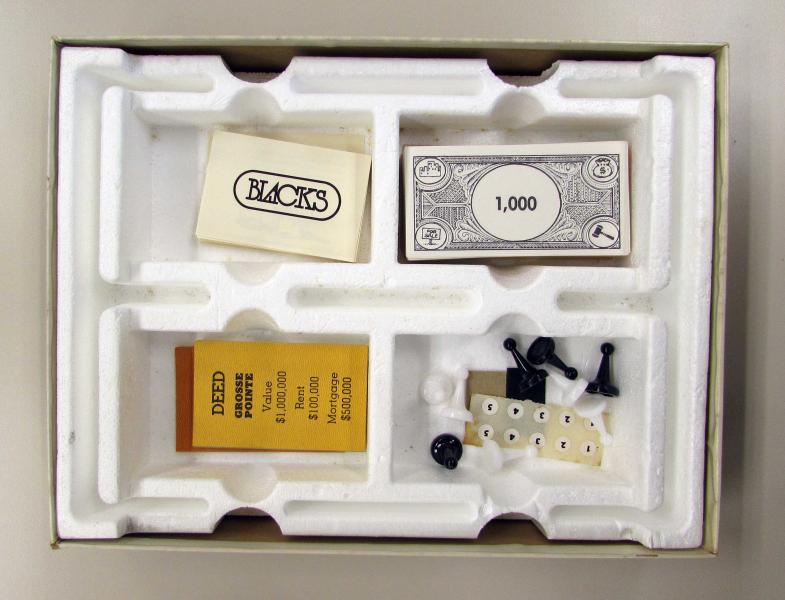Beyond the Book: Board Games and Materials with Multiple Parts
Nora Gabor, Rare Books Librarian, DePaul University
In this installment of Beyond the Book: Preserving Your Non-Book Collections, I will describe the care of objects with multiple parts, specifically board games. While board games are usually self-contained in a box, preserving them is not always as simple as putting the box on a shelf. DePaul University’s approach to these items is similar to many others in our collections; we consider what type of materials were used to create the game and how the game will be stored. Board games contain many parts, including the board, game pieces, and interior storage components. Depending on their time period, the parts can be made of paper, plastic, linen, wood, metal, porcelain, earthenware, and even bone. Board games are also designed to be stored horizontally which requires more shelf space. While the path to getting these types of items ready to go on the shelf is different depending on the type of material, the ultimate goal remains the same: to safely store all of the pieces together in one enclosure if possible, and to protect and preserve the integral parts of the game.
I recently worked with the board game Blacks and Whites: The Role Identity & Neighborhood Action Game that was published by Psychology Today in 1970 to demonstrate the economic inequalities faced by African Americans.

My main preservation concern was the original styrofoam tray in which the pieces were stored. Besides a tendency to break apart, the styrofoam also had an undesirable odor.

As a replacement for the styrofoam, I created a new storage tray to fit inside the original game box made from acid free archival corrugated board and built the tray similar to a built-up book box.
Instead of creating little compartments within the tray for the pieces, I opted to store them together in acid free envelopes and layer the envelopes. The envelopes fit snugly in the tray so the pieces cannot move about and get damaged.

To imitate the original design of the board game’s interior storage, I created a slot for the board to rest on top, further helping to keep the envelopes in place.
The board itself was designed to be stored folded and currently is in very good shape so I felt comfortable leaving it folded. If the board had been made from only stiff paper or if the joints were excessively worn, I would have stored it flat like other large paper documents and created a larger enclosure to keep all of the materials together. If the playing surface had just been paper rather than paper and board, I would have also considered encapsulating it in mylar to provide extra protection and support. Additionally, this game’s box is stable enough to go straight on the shelf; however, one may consider creating an enclosure to protect the designs on the box’s surface.
Other than the construction of a better long-term storage container within the box, the preservation principles employed are similar to those used for paper-based items. This game is stored horizontally in secure stacks where the climate is monitored and exposure to light is limited. While this item is mostly paper-based, some antiquarian games have playing surfaces made of paper on linen. The pieces can be made of materials like porcelain, earthenware, bone, or metal rather than wood or plastic as found in current games. For ceramics, it is recommended to place pieces in a secure enclosure that will not be jostled in storage. Acid-free, lignin-free tissue can be used to wrap the items individually so they do not collide with each other and cause damage. Tissue can be used to wrap and cushion bone and metal board game pieces. Playing surfaces consisting of paper adhered to linen require monitoring because both textiles and paper are climate sensitive. For these materials and all the others mentioned, reducing light exposure, protecting from dust and dirt, and closely monitoring the environment are essential for preserving the games. To learn more about the preservation of textiles and large paper-based items, you can check out relevant articles on the Beyond the Book: Preserving your Non-Book Collections website. Additional resources for the material types mentioned in this article are suggested below. Although preservation techniques are similar for many of these materials, it is always a good idea to consult with a conservator if you have specific questions or concerns.
References and Resources:
American Institute for Conservation of Historic and Artistic Works. "Ceramics and Glass." Caring for your Treasures.
American Institute for Conservation of Historic and Artistic Works. "Documents and Art on Paper." Caring for your Treasures.
Indiana University Libraries. "Built-up Box Repair.” Indiana University Libraries Book Repair Manual. 2016.
National Park Service. "Appendix I: Curatorial Care of Archeological Objects." NPS Museum Handbook, Part I: Museum Collections. 2001.
Northeast Document Conservation Center. Storage and Handling: 4.9 Storage Solutions for Oversized Paper Artifacts.
Paris, Jan. "7.7 Choosing and Working with a Conservator" NEDCC Preservation Leaflets. 2018.
Return to Beyond the Book: Preserving your Non-Book Collections

